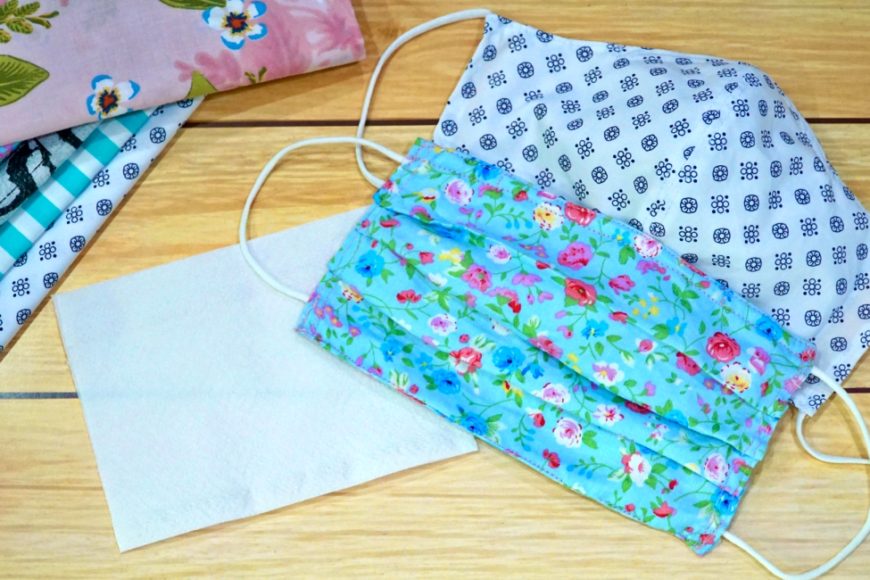
How to Make Your Own DIY Face Mask
The COVID-19 situation is rapidly evolving. Scientists continue to study the virus to find better ways to prevent it and treat it. The CDC recently recommended the use of cloth face coverings in public areas as a way of reducing the spread of the virus. But with masks in short supply and medical staff in need of the most protective models, many people are resorting to making their own face masks to help protect their communities.
Luckily, making your own face mask isn’t complicated. You can make face masks with materials you probably already have on hand, and you don’t need to know how to sew. Here’s what you need to know to put together a DIY face mask!
No-Sew Face Mask
No-sew face masks are probably the easiest option to put together quickly in a pinch. If you’re running for groceries later, you can have one ready to go before you step out in public.
The CDC has two no-sew tutorials. One no-sew tutorial involves cutting a t-shirt, leaving strips of fabric to tie together to fasten the mask. The other no-sew tutorial involves folding a bandana around a cut coffee filter, then securing to the ears with rubber bands or hair ties.
Here are a few helpful no-sew tutorials:
- Face Mask for Kids and Adults via Creative Fashion Blog – This tutorial uses fabric adhesive to hold the mask together without any sewing.
- Easiest DIY Face Mask via Cool Mom Picks – This option is so easy that even craft-phobic people should be able to handle it.
Sewn Face Masks
The CDC tutorial suggests stacking two rectangles of tightly-woven cotton fabric, folding over the edge, and hemming them. Run elastic through the hem to create ear loops to secure the mask to the face.
Here are some tutorials:
- DIY Face Mask with Ties, Fitted Nose and Filter Pocket via Melanie Ham – If you’re looking for a mask you can wear more often, this might be a good choice. The pocket also makes it easy to change the filter.
- Surgical Face Mask for Hospitals via Sarah Maker – Whether you prefer ties or elastic straps, this tutorial can help you put together a reusable mask.
Types of Materials
- Shop Towels – Business Insider reports that a small clothing manufacturer found blue shop towels filtered particles better than cotton, so if you have a clean shop towel at home, it may be particularly useful.
- Quilting Fabric or Cotton Sheets – The CDC suggests these materials as appropriate due to their tighter weaves.
- Bandanas – Bandanas are one of the most convenient materials to use, and many no-sew tutorials show easy folding methods.
- T-Shirt Fabric – The CDC says t-shirt fabric will work “in a pinch.” It often has a relatively loose weave, so it may not be as effective as other materials.
- Leggings – Many tutorials use old leggings to make face masks. These may be convenient and make use of the materials you have on hand, but it is unclear whether they are effective at filtering.
- Coffee Filters – Tutorials frequently include a cut coffee filter in the front of the mask as an additional measure to reduce particles.
- HEPA Furnace Filters and Vacuum Cleaner Bags – The New York Times reports that HEPA furnace filters and vacuum cleaner bags filter microscopic particles well, making them a popular choice for DIY face masks.
Things to Keep in Mind
- The CDC does not recommend the use of face masks for children under 2, people with breathing difficulties, and/or people who are unconscious or who would be unable to remove their face mask.
- Wash your mask regularly to keep it clean.
- Do not touch eyes, nose, or mouth as you remove your mask. Wash your hands thoroughly afterward.
- Masks are intended as an additional measure to prevent the spread of COVID-19, but people should continue to practice social distancing efforts and wash their hands thoroughly.
- If you have no symptoms, you could still have COVID-19. Wearing a mask even when you have no symptoms may stop you from unknowingly spreading it.
This does not constitute medical advice. We strongly recommend following instructions from your doctors, the CDC, and WHO to stay safe and stop the spread of COVID-19.



